I am posting a Code for JK Flip flop in VHDL language. the code is correct according to the JK flip flop circuit. but i got output as red line. can any one tell me the what is the problem with only JK flip flop only.
- Programme: JK Flip Flop
----------=======NAnd Gate with three inputs=====---------------
library ieee;
use ieee.std_logic_1164.all;
entity nand_gate3 is port(
A, B, C : in std_logic;
F : out std_logic);
end nand_gate3 ;
architecture nandfunc3 of nand_gate3 is
signal x : std_logic ;
begin
x <= A nand B ;
F <= x nand C ;
end nandfunc3;
------====== END NANd GATE with three inout ======--------
----=========NANd Gate with Two inputs==========------------
library ieee;
use ieee.std_logic_1164.all;
entity nand_gate2 is port(
A, B : in std_logic;
F : out std_logic );
end nand_gate2;
architecture nandFunc2 of nand_gate2 is
begin
F <= A nand B ;
end nandFunc2;
------====== END NANd GATE with three inout ======-
library ieee;
use ieee.std_logic_1164.all;
ENTITY JK_flipflop IS PORT (
clk , J, K : IN std_logic;
Q , Q_bar : OUT std_logic );
END JK_flipflop ;
architecture JK_structure OF JK_flipflop IS
----===Compnents
COMPONENT nand_gate3 IS PORT (
A, B ,C : IN std_logic ;
F : OUt std_logic );
End Component ;
COMPONENT nand_gate2 IS PORT (
A, B : IN std_logic ;
F : OUt std_logic );
End Component ;
Signal X, Y , Qback ,Qbar_back: std_logic ;
----== Structure
Begin
U1: nand_gate3 PORT MAP ( J, clk, Qbar_back, X );
U2: nand_gate3 PORT MAP ( K, clk, Qback ,Y );
U3: nand_gate2 PORT MAP ( X, Qbar_back ,Qback);
U4: nand_gate2 PORT MAP ( Y, Qback ,Qbar_back);
Q <= Qback;
Q_bar <= Qbar_back;
END JK_structure ;
--------------------Test Bench for JK flip flop----===
library ieee;
use ieee.std_logic_1164.all;
entity jk_flipflop_tb is
end jk_flipflop_tb ;
architecture tb of jk_flipflop_tb is
---====Jk_flipflop
component JK_flipflop is port(
clk,J , K : in std_logic;
Q, Q_bar : out std_logic);
end component;
---===signals
signal clk,J ,K , Q, Q_bar : std_logic;
begin
mapping: JK_flipflop port map(clk, J, K, Q, Q_bar);
-------=========Process for Clcok ===========---------------
process
begin
clk <= '1';
wait for 5 ns;
clk <= '0';
wait for 5 ns;
end process;
--------===========Process for j,k inputs values=======--------------
process
begin
-------===TEST 1
J <= '0';
K <= '1';
wait for 20 ns;
-------====TEST 2
J <= '1';
K <= '1';
wait for 20 ns;
-------====TEST 3
J <= '1';
K <= '0';
wait for 20 ns;
-------====TEST 4
J <= '0';
K <= '0';
wait for 20 ns;
end process;
end tb;
--------------------------------------------
configuration cfg_tb of jk_flipflop_tb is
for tb
end for;
end cfg_tb;
---------======------
